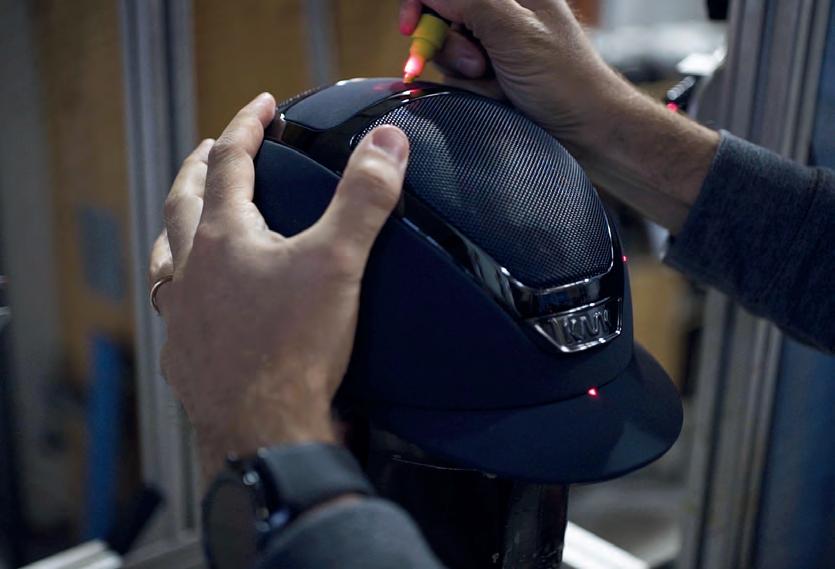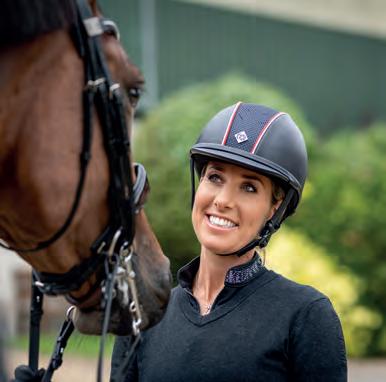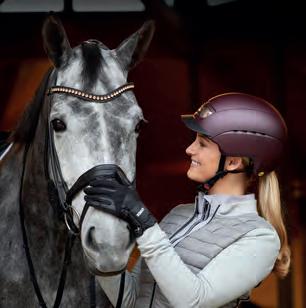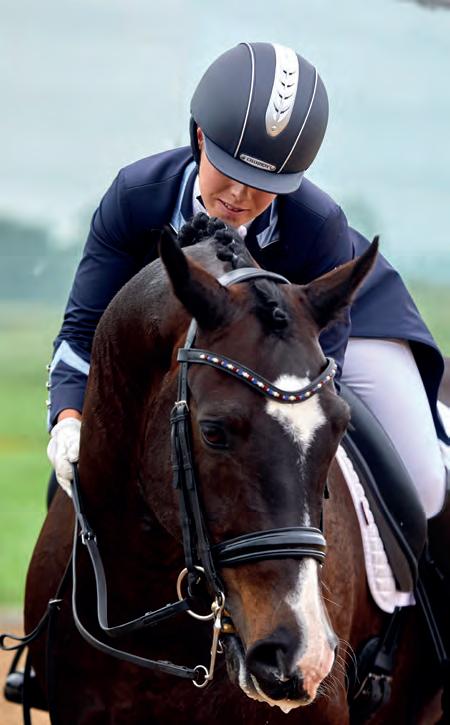
5 minute read
Heads up
With the release of new guidelines focused on recognising and managing concussion in equestrian sport, Emma Penny looks at what hat manufacturers are doing to keep us safer.
does not always occur – in fact, it occurs in less than 10% of concussions. While helmets save lives, concussions can still occur and can threaten the long-term health of participants, says British Equestrian.
For UK-based hat manufacturer Charles Owen, understanding more about concussion and brain health is crucial. It has been part of a group which has previously supported 10-13 PhD projects in the area, with research results driving ongoing safety improvements. It is currently co-sponsoring two students at Cardiff University with the NFL looking at sub-concussion in sport, explains university research leader, Dr Peter Theobald.
“The brain is surrounded by a thin layer of fluid within the skull, meaning that it is effectively floating and so may collide with the inside of the brain during a head impact.
“We are using a World-leading MRI scanner to investigate whether low-energy head impacts – achieved by heading a football – causes any change in the brain microstructure. By collecting data before and after the heading, we mathematically compare the images to determine whether there have been any changes to the nerve fibres, microscopic structures that are critical for effective brain function.
“We also use these data to build brain models within a computer environment, such that we can then simulate more severe impacts – like equestrian falls, and be confident in our predicted injury severity. This provides a unique and highly valuable ‘test bed’ for us to design high quality, high performance equestrian hats,” says Dr Theobald.
Matt Stewart, head of innovation at Charles Owen, says that changes in the brain fluid from a sub-concussive injury can still be present months later, and this type of research will help drive forward safety standards for everyone in the sector. He has also co-authored scientific research papers looking at issues such as improving current testing methods to make them more ‘real-life’ relevant. He also sits on industry committees, and explains that manufacturers are actively looking at technology and developments in sports such as cycling and skiing.
Champion, which also works with Cardiff University and other international research groups, says it looks at various sports, such as cycling and skiing, for inspiration and technological innovation. “However, not all developments can be used directly due to the requirements of equestrian standards that do not have a parallel in other sports,” it says.
“Some features of interest would be the integration of lights into helmets, smart
Pictured

Pictured
Left inset: Designs from ABUS cover more of the rider’s head, a practice which is also being followed in the company’s established cycle helmet business.
Right: Hats go through extensive testing procedures by manufacturers such as Charles Owen, including the ability to withstand a sharp penetration.

storage of user information, and recoverable helmet liners such as Koroyd.” This is a material currently used in ski and sailing helmets which crumples instantly and consistently on impact says its manufacturer, absorbing maximum force in a controlled manner, minimising energy transferred to your head. It is not currently used in equestrian sports.
One of the technologies which is gathering pace in equestrian helmets, MIPS, has been popular in cycling helmets for some years. MIPS – which stands for Multi-Directional Impact Protection System – is designed to help reduce the brain’s rotation during a fall. An extra shell or layer between the hat’s shell and padding redistributes impacts to help protect the skull and brain.
MIPS is available in helmets from a range of manufacturers, including Champion, Charles Owen and Uvex, while Shires says it is currently in discussions about adding the technology to its helmets, which will include a new Ellipse range launching in June.

With growing recognition about the importance of protection from rotational impact, Matt Stewart adds that there are new technologies appearing now which will provide a similar function; several manufacturers are looking at these.
Measuring rotation impact has inspired Italian manufacturer KASK to develop its own test. This is based on a motorcycle helmet standard, and involves an angled anvil hitting the helmet at 6m/s at various points. It says the findings from this have played a pivotal role in how it integrates new materials and technologies into its helmets. Performed at the Newton Lab – a certified testing laboratory in Milan – the KASK Rotational Impact WG11 Test draws from the research of industry experts and academics to improve the way helmets are assessed against rotational forces.
KASK, along with Uvex, produces helmets for other industries and sports – both are
Pictured
well-known in snowsports and cycling, and KASK is also providing helmets for the Ineos Americas Cup sailing team.
A background in sport – through cycling – is where a new equestrian helmet brand has come from. Abus, which is a family-owned business based in Germany, is one of the world’s largest cycle helmet manufacturers, and is about to launch two new models in the UK market in conjunction with Pikeur.
Marc von Dunten, head of quality and research at Abus, explains that it has its own development and testing lab for helmets, as well as working closely with professionals in cycling, and now riding, including Olympic Champion Jessica von Bredow-Werndl. Feedback from people who are wearing helmets for six plus hours per day has helped develop all of its helmets, he says. He adds that its equestrian helmet is one of few which fulfils all safety standard requirements, and it has made a point of producing a deeper helmet to protect more of the head, something which it has done for many of its cycle helmets. Its Air Duo riding hat, which has a removable peak, doubles as a cycle helmet. Monty Stuart-Monteith of Shaws Equestrian, the UK Pikeur distributor, says he believes the UK market is one where people are more safety aware. He cites the 2012 Olympic dressage and the rule change from wearing top hats to safety helmets as an ‘extraordinary move’ which helped increase awareness of the importance of wearing safe headwear.
Charles Owen’s Matt Stewart believes manufacturers are striving for one thing; “Ultimately, we are all trying to make a safer helmet.”
• The British Equestrian concussion information can be found here: britishequestrian.org.uk/ other-pages/concussion
Choosing A Hat
It is easy to become a bit confused by changing safety standards, and although a new EN1384 standard is due to be agreed and is likely to supercede the VG1 European standard, Charles Owen, Champion and Shires believe anyone looking for a new hat should opt for one certified to PAS015.
“We feel this is the best equestrian standard on the market,” says Champion. “We would also urge people to consider helmets with MIPS as this technology can increase the performance of a helmet,” it adds.


Matt Stewart says he believes opting for a helmet with three safety standards will give the optimum safety coverage as the criteria and thresholds are slightly different for each one.
Getting it professionally fitted is also essential. “A well-fitting helmet is so much safer. A loose one can expose the front or back of your head, or break your nose. They also need to be buckled up.”
#CHECKYOURLABEL

The standards shown on your helmet label tell you which types of riding accident scenarios your helmet has been tested for.
90% of Charles Owen helmets meet three safety standards. Your local Charles Owen stockist can advise the most s uitable helmet for your needs.










